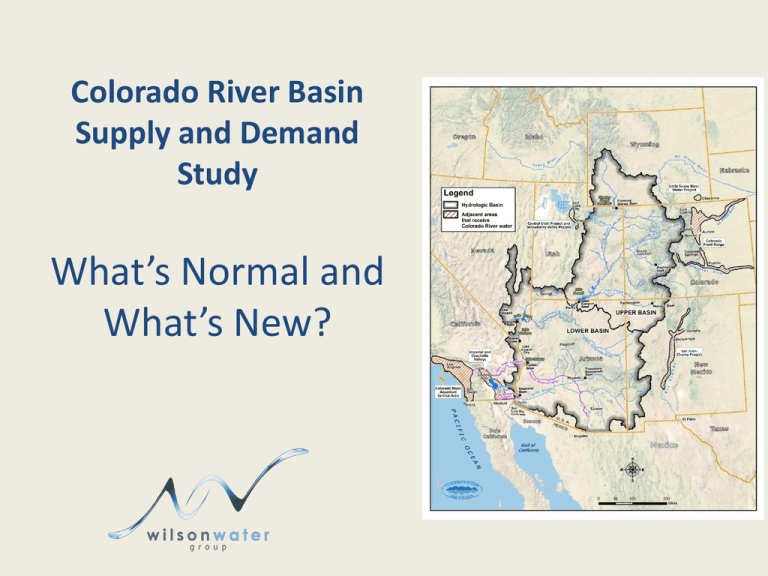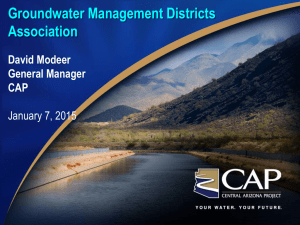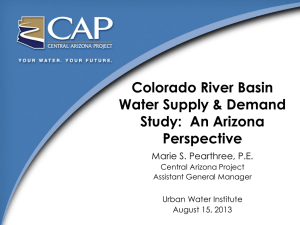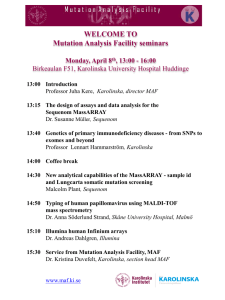Colorado River Basin Supply and Demand Study
advertisement

Colorado River Basin Supply and Demand Study What’s Normal and What’s New? Disclaimer The views presented are my interpretation of the results and important issues from the Colorado River Basin Supply and Demand Study. These views do not represent the official views of the Colorado Water Conservation Board, the Colorado Attorney General’s Office, the Colorado Division of Water Resources, the Colorado River District, the Southwest Water Conservation District, the Front Range Water Council, the [insert name here]……. Colorado River Basin Study Purpose • Define future imbalances in the water supply and demand for Colorado River water • Analyze adaptation and mitigation strategies to resolve those imbalances • Study report is not a decisional document but is considered a call to action for next steps Colorado River Demand in Colorado * 4,000 Apportionment * Includes ~250 KAF CRSP Reservoir Evaporation 3,500 USBR CU & Loss Estimate (2006-2010 Average) 3,000 KAF 2,500 2,000 1,500 1,000 500 0 2015 2035 2060 Current Projected (A) Slow Growth (B) Rapid Growth (C1) Rapid Growth (C2) Enhanced Environment (D1) Enhanced Environment (D2) Lower Basin Demand * Upper Basin Demand * 12.0 12.0 MAF 8.0 10.0 Apportionment 8.0 MAF 10.0 6.0 6.0 4.0 4.0 2.0 2.0 0.0 0.0 2015 2035 2060 2015 2035 2060 Current Projected (A) Slow Growth (B) Current Projected (A) Slow Growth (B) Rapid Growth (C1) Rapid Growth (C2) Rapid Growth (C1) Rapid Growth (C2) Enhanced Environment (D1) Enhanced Environment (D2) Enhanced Environment (D1) Enhanced Environment (D2) * Upper Basin Includes 0.5 MAF of CRSP Evaporation Lower Basin Includes 1.2 MAF of Evaporation “Normal” for Colorado/ Upper Basin • Colorado and Upper Division Projected demands do not reach Full Apportionment by 2060 • Colorado and Upper Division Projected demands are higher than actual depletions • Lower Division demands exceed Apportionment currently Annual Observed Natural Flow Colorado River at Lees Ferry Annual Flow 30,000 10-Year Running Average 25,000 Kaf 20,000 15,000 10,000 5,000 0 1906 1916 1926 1936 1946 1956 1966 1976 1986 Ranges from 5.5 MAF to 25 MAF Mean Annual Flow (1906 to 2008) = 15 MAF Mean Annual Flow (1991 to 2010) = 13.7 MAF Mean Annual Flow (1951 to 1970) = 13.2 MAF 1996 2006 Annual Climate Projected Natural Flow Colorado River at Lees Ferry Range of Lees Ferry Natural Flow Sequences used in the Downscaled GCM Projected Scenario 50,000 45,000 40,000 35,000 KAF 30,000 25,000 20,000 15,000 10,000 5,000 0 GCMs Annual Flows Range from 4.2 MAF to 44 MAF Average Mean Annual Flow for all 112 GCMs = 13.7 MAF 25% of GCMs predict Mean Annual Flow > 15.0 MAF 25% of GCMs predict Mean Annual Flow < 12.5 MAF “Normal” for Colorado/Upper Basin • Planning for hydrologic variability and prolonged drought is normal • Risk of Lee Ferry Deficit was considered during the Compact negotiations • Historical Climate Variability is why the CRSP Reservoirs were built “Normal” for Colorado/ Upper Basin • Shortages in the Upper Basin are primarily due to limited supply, and are nothing new • Colorado water users understand risk • Tributary agricultural users are supply-limited in the late irrigation season nearly every year 30000 0.60 25000 0.50 20000 0.40 15000 0.30 10000 0.20 5000 0.10 0 0.00 Jan Feb Mar Apr May Jun Jul Aug Sep Oct Nov Dec Ave Monthly Flow Ave Monthly CIR Inches AF Tomichi Creek at Gunnison New Normal • Upper Basin is experienced at planning/ adapting to variable climate and risk • Lower Basin may not be as “seasoned” • About ½ of the GCMs result in at least 1 year of Lee Ferry Deficit between 2040 and 2060 • Climate change vs prolonged drought and climate variability creates more urgency New Normal • Global climate modeling is a new and rapidly changing science CMIP 3 CMIP 5 Time Horizon 1950-2099 1950-2099 Emission scenarios 3 (SRES A2,A1B,B1) 4 (RCP 2.6, 4.5, 6.0, 8.5) Climate Modeling Groups 14 23 Global Climate Models (GCM) 16 37 Ensemble members 112 234 2° 1° 1/8° 1/8° Tavg (°C), P(mm/day) Tmin(°C), Tavg (°C), Tmax(°C), P(mm/day) GCM Regrid Resolution BCSD Resolution Monthly Output Variables New Normal New Normal Key Metrics for Colorado • Lee Ferry Deficit – Indicates Risk associated with development of Compact Entitlement • Upper Basin Shortages – Indicates Supply for consumptive uses • Flows at Critical Locations – Indicates Supply for non-consumptive needs Options to Mitigate Imbalances • Options and Strategies investigated – Increase Supply – Reduce Demand – Modify Operations Indicator Metrics and Signposts Indicator Metric/ Vulnerability Lead Time (years) Conditions Lake Powell Lake Mead Natural 5-year Mean Flow at Lees Ferry Upper Basin Shortage Lee Ferry Deficit 5 3490’ NA 12.39 maf NA Lower Basin Shortage (>1 maf over 2 years) 3 NA 1060’ 13.51 maf NA Lower Basin Shortage (>1.5 maf over 5 years) 3 NA 1075’ 13.51 maf NA Mead Pool Elevation (< 1,000 feet msl) 3 NA 1040’ 13.35 maf NA 0 NA NA NA 25% Upper Basin Shortage (>25%) A good Signpost anticipates a vulnerable conditions, but does not trigger action unnecessarily. Anticipating a potential Lee Ferry Deficit is the key to responsible future development. Normal Options • Large Scale Import Options and Strategies provide largest benefit • Desalination from the Pacific Ocean and imports from other rivers would require long lead-times to permit • Conservation and Reuse • Upper Basin imbalances are not significant; “Normal” Options and Strategies primarily benefit the Lower Basin New Normal Options • Upper Basin Water Banking Option was proposed by Conservation Groups primarily for environmental/recreational flows • Water Banking could mitigate a potential Lee Ferry Deficit • Water Banking is being further considered in Basin Study Next Steps, by Colorado, and by the Upper Basin States Next Steps for Colorado • Adopt Signpost Approach • In lieu of spending effort determining probability of a Lee Ferry Deficit – Refine the signposts – Build the technical, legal, and policy requirements to implement Options and Strategies when needed • Support the Lower Basin to find solutions to their over-apportionment issues Next Steps for Colorado • Provide Support for Data Development – Continue to support Climate Science Research – not to identify probabilities, but to understand the future range of possibilities – Support Conservation Studies to look realistically at how much demand reduction is possible – Help Study Team understand legal and policy implications associated with Conservation, Reuse, and Water Banking Colorado’s Challenges • Drama makes the news – “Study shows a 3.2 MAF imbalance in the Colorado River”. Once published, this became the tag-line. – No recognition in the Study that imbalances assume Lower Basin can develop their projected demands well beyond apportionments. – No recognition in the Study that Upper Basin has always experienced shortages Colorado’s Challenges • Results can be “picked” to make any point • “Climate-change projections show 10 to 30 percent less water in the river by 2050.” (Denver Post, American Rivers) – Only if you select the driest of the 112 GCMs – All 112 projections range from 20 percent more to 30 percent less water – Context is important when reading articles/white papers published by advocacy groups “Normal” for Colorado/ Upper Basin • Study does NOT indicate an immediate crisis for Colorado, however does highlight the continued importance of continuing to considering the Risk of a Lee Ferry Deficit associated with both current use and future development






